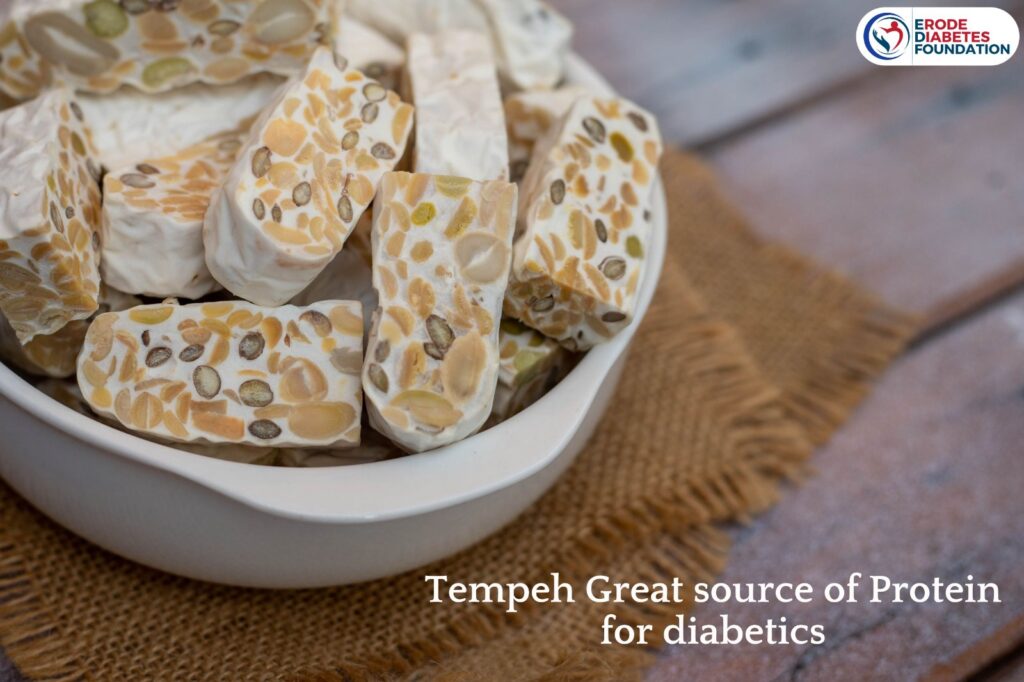Protein is important for everyone, especially for those managing diabetes. While non-vegetarians have various options, finding the right protein sources can be challenging for vegetarians, especially for those with diabetes. While paneer, tofu, lentils, and beans are well-known, tempeh remains relatively unfamiliar. In this blog post, we’ll explore the nutritional benefits of tempeh as a great source of Protein for diabetics, and tips to include tempeh in a diabetic friendly food plan to meet your protein needs.

What is Tempeh?
Tempeh is a traditional Indonesian fermented soy product. It is globally well-known for its nutritional value and adaptability. Filled with protein, fibre, vitamins, and minerals, it’s a popular choice for health-conscious individuals. Further, adding tempeh into your diet can be a good way for improving protein intake and blood sugar control.
Nutritional Benefits of Tempeh:
Nutritional Values of Tempeh (per 100 grams)
- Protein: Approximately 19 grams, Further, it helps muscles stay strong and repairs them.
- Fiber: Around 8 grams. Also, it makes digestion easier, keeps you full, and helps control blood sugar.
- Carbohydrates: Approximately 9 grams. It is low, so they won’t raise blood sugar quickly.
- Fat: About 11 grams, mostly healthy fats, good for the heart.
- Vitamins and Minerals: Packed with iron, calcium, magnesium, potassium, and B vitamins like riboflavin, niacin, and vitamin B6.
- Calories: Approximately 193 kcal
Tips for including Tempeh in your Diabetic Food Plan
Here are some practical tips for including protein for diabetics by including Tempeh in your diabetic friendly food plan:
1. Keep Moderate Portion size
Have about 3 to 4 ounces (about 85 to 113 grams) of tempeh per meal. This portion size provides a balanced amount of protein, fiber, and other nutrients without significantly impacting blood sugar levels.
2. Balanced Meals
Also, you can pair tempeh with non-starchy vegetables like spinach, broccoli, or bell peppers, and whole grains such as brown rice or millets. Further, combining healthy fats like olive oil or avocado can improve the nutritional value of the meal.
3. Cooking it Healthily
Avoid deep-frying tempeh, as it can increase the calories and fat content of the dish. Instead, choose for healthier cooking methods like grilling, baking, or stir-frying with very little oil.
4. Flavourful Seasonings
You can use herbs, spices, and low-sodium sauces to make tempeh tasty without adding extra sugar or salt.
5. Try different Recipes
Try various recipes such as stir-fries, curries, salads, wraps, or sandwiches. Its firm texture and nutty flavour make the food extra tasty. Learn why tempeh is a great protein option for people with diabetes, providing a tasty alternative to foods like tofu and lentils.
To conclude
Furthermore, consultation with your diabetologist/dietitian is essential for dietary recommendations personalized to individual health needs and goals. With its nutrient density, low glycemic index, and wide culinary availability, tempeh can be a great source of protein for diabetics. Also, it can be a valuable addition to your diabetic diet, promoting better blood sugar control and overall well-being.


